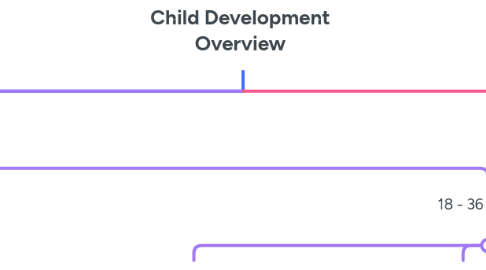
1. Foetal
1.1. Development Milestones
1.1.1. Month 1 - Brain begins to form
1.1.1.1. Month 3 - Sense of smell and hearing, respond to stimuli
1.1.1.1.1. Month 4 - Sense of taste, foetal programming (adapt to external factors eg how much food mum is eating)
1.2. Environmental influences on development
1.2.1. Maternal health problems - eg EDs, diabetes, high blood pressure, thyroid disease
1.2.1.1. Maternal drug use - eg SSRIs, smoking, illicit drugs
1.2.1.1.1. Maternal lifestyle - eg weight, diet
1.2.1.1.2. Maternal alcohol use - leads to foetal alcohol spectrum disorders
2. Infancy + Toddlerhood
2.1. Birth - 12 months
2.1.1. Physical development milestones (PDM)
2.1.1.1. 3 - 4 months - more hand, body and head movement, rolling from tummy to back, grabbing things, inspecting things
2.1.1.1.1. 5 - 6 months - increased body movement, proper head control, increased hand-eye coordination, touching and tasting to learn about things
2.1.2. Language/communication development milestones (LCDM)
2.1.2.1. 3 - 4 months - more emotion, beginning of verbal communication, facial expressions, voice recognition, reply attempts
2.1.2.1.1. 5 - 6 months - attachments, stranger anxiety, accurate facial expressions, communicate by babbling and other noises and movements
2.1.3. Cognitive and socioemotional development milestones (CSDM)
2.1.3.1. 4 months - smiles to gain attention, laughs, looks/moves/makes sounds to gain or keep attention, looks at hands with interest, when hungry opens mouth when sees breast or bottle
2.1.3.1.1. 6 months - knows familiar people, likes to look at self in mirror, reaches to grab toy they want, closes lips to show not hungry
2.2. 12 - 18 months
2.2.1. PDM
2.2.1.1. 12 - 15 months - builds, scribbles, pegs in basket, exploration, standing without needing help, climb stairs/furniture
2.2.1.1.1. 15 - 18 months - walking on their own, running, walking up/down stairs, climbing furniture, pick up small objects, sophisticated hand movements increasing
2.2.2. LCDM
2.2.2.1. 12 - 15 months - empathy, separation anxiety, babbling includes real words, naming objects
2.2.2.1.1. 15 - 18 months - pretend play, side by side play, strong attachments, separation anxiety, naming objects and actions, understand their own name, learn the power of 'no'/'mine'
2.2.3. CSDM
2.2.3.1. 15 months - copies others while playing, shows objects they like, shows affection, tries to use things the right way, stacks 2+ small objects (eg blocks)
2.2.3.1.1. 18 months - proximity maintenance, points to show interest, helps you dress them, copies you doing chores, plays with toys ie pushing a toy car
2.3. 18 - 36 months
2.3.1. PDM
2.3.1.1. 18 - 24 months - running, scribbling, building, imagining and creating, increasing independent skills, beginning toilet training
2.3.1.1.1. 2 years - kicks a ball, runs, walks up stairs, eats with spoon
2.3.2. LCDM
2.3.2.1. 18 - 24 months - learning 1-2 new words a week, tone, naming objects, people and body parts, using simple sentences, new big feelings increase temper tantrums, decreased separation anxiety
2.3.2.1.1. 2 years - answers questions with body language, more gestures, at least 2 words together, at least 2 body parts when asked to show you
2.3.3. CSDM
2.3.3.1. 2 years - notices when someone is hurt/upset and pauses/looks sad when someone is crying, looks at your face to gauge reaction to new situation, tries to use switches/knobs/buttons, uses both hands to complete a task/play, plays with 2+ toys at once
2.3.3.1.1. 30 months - plays near and sometimes with children, 'look at me!', follows simple routines, plays pretend with toys, simple problem-solving skills, 2 step instructions, at least 1 colour
3. Early Childhood
3.1. 3 - 4 Years
3.1.1. PDM
3.1.1.1. 3 years - threading, putting easy clothes on, uses fork; arts and crafts; running and playing
3.1.2. LCDM
3.1.2.1. 3 years - 'who'/'what'/'when'/'where'/'why', first name, actions, short conversations, clear enough speech
3.1.3. CSDM
3.1.3.1. 3 years - draws circle when shown, avoids hot objects when warned; calms after 10 minutes of drop-off, notices and joins other children in play; learns individuality, simple emotions, fear of imaginary things, empathy and care for familiar others; playing with and making friends; increased sharing, imaginative play
3.2. 4 - 5 Years
3.2.1. PDM
3.2.1.1. 4 years - catches ball most of time, unbuttons, holds pencil between finger and thumb, serves food/pours water
3.2.2. LCDM
3.2.2.1. 4 years - 4+ word sentences, answers simple questions, tell 1+ thing that happened that day
3.2.3. CSDM
3.2.3.1. 4 years - names colours, what comes next in known story, draw person with 3+ body parts, role-play, comforts others, avoids danger, likes to be a helper, changes behaviour based on context
3.3. 5 - 6 Years
3.3.1. PDM
3.3.1.1. 5 years - buttons buttons, hops on one foot
3.3.2. LCDM
3.3.2.1. 5 years - answers simple qs about book/story just read/told, 3+ back and forths in conversation, simple rhymes, tell 2+ event stories
3.3.3. CSDM
3.3.3.1. 5 years - follows rules, performs for you, simple chores, count to 10, names 1-5, time words, writes some letters in name, names some letters
